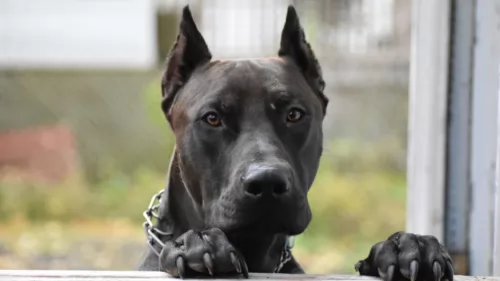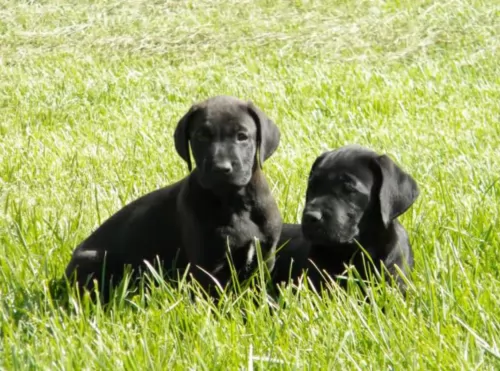 MyDogBreeds
MyDogBreedsTurnspit Dog is originated from United Kingdom but Canis Panther is originated from United States. Turnspit Dog may grow 47 cm / 18 inches shorter than Canis Panther. Turnspit Dog may weigh 51 kg / 112 pounds lesser than Canis Panther. Turnspit Dog may live 3 years more than Canis Panther. Both Turnspit Dog and Canis Panther has almost same litter size. Both Turnspit Dog and Canis Panther requires Low maintenance.
It is amazing that this small dog’s popularity comes from him being used in the kitchens to roast meat. The British enjoyed eating their meat which they roasted on a fire.
These dogs were essentially regarded as a tool – a means to an end, and when kitchens were modernized, they were no longer needed, and they became extinct.
Referred to as the kitchen dog or cooking dog, the first mention of these little dogs was made in 1576. By 1850 the dogs had become scarce and by 1900 it seemed as though there were none left.
 The Canis Panther is a strong, muscled dog who has been developed in the USA in the 1970s by Scorpio Jones, Michael Stratten, and Lucas Lopez. They mixed the Doberman Pinscher, the Great Dane the Labrador Retriever and the American Staffordshire Bull Terrier.
The Canis Panther is a strong, muscled dog who has been developed in the USA in the 1970s by Scorpio Jones, Michael Stratten, and Lucas Lopez. They mixed the Doberman Pinscher, the Great Dane the Labrador Retriever and the American Staffordshire Bull Terrier.
This dog hasn’t got a long history, having only been established in the 1970's, but the breeders wanted a dog much like the Doberman but somewhat larger and stronger. It is a dog breed which is still fairly unknown in the United States and elsewhere.
The Turnspit was a small long-bodied dog, standing at between 20 to 30cm in height and probably weighed anything between 9 and 14kg in height.
The legs were somewhat crooked or bandy and Edward Jesse, who wrote ‘Anecdote of Dogs’ in 1846 described them as ugly dogs with a miserable look to them. That was probably due to him having to fit into the hamster-like wheel contraption that turned the meat being roasted in the kitchens.
They were low-bodied dogs, similar to a Dachshund or a Corgi with short, stocky legs, short floppy ears, and a short coat. The long tail curled over its back. It is believed that the coats were white, reddish-brown, gray or black.
The dog was certainly feisty, energetic and hard-working with not much being written about his temperament. He was a working dog, but given the chance, he would no doubt have been loving and loyal, longing for the chance just to be part of a human family and to be loved.
 The Canis Panther is a large dog measuring roughly 68 – 77 cm in height and weighing around 50 to 63 kg. He has a deep chest and strong neck. The coat is short and dense and it is is essentially a solid color - fawn, grey, blue, chocolate or black.
The Canis Panther is a large dog measuring roughly 68 – 77 cm in height and weighing around 50 to 63 kg. He has a deep chest and strong neck. The coat is short and dense and it is is essentially a solid color - fawn, grey, blue, chocolate or black.
He looks magnificent with his cropped ears and short docked tail. Unfortunately with regulations surrounding the docking of dog’s tails, the dog these days is often left with a long tail.
He is an intelligent, territorial dog and makes an excellent watchdog. He is a dog which can be easily trained and socialized and then he makes a great family dog. He is loving and loyal to his human family, being somewhat aloof with strangers. His gets along well with children in the home as well as with other pets.
The Turnspit dog had a tough life, but would no doubt have made a wonderful little pet had he just been allowed to be a companion dog.
Make sure that when you buy a dog, you don't just put him in your backyard and forget about him. Give him the love and care he deserves.
 The Canis Panther is a loving dog in spite of his large, guard-dog looks. He is intelligent, bold and courageous, and when trained and socialized is a devoted, loyal, loving pet.
The Canis Panther is a loving dog in spite of his large, guard-dog looks. He is intelligent, bold and courageous, and when trained and socialized is a devoted, loyal, loving pet.
He is known for his high intelligence and becomes so attached to his human family he will fight to the death for them if needs be. He is a territorial dog and won’t welcome strangers to his door.
The Canis Panther puppy is outgoing and playful, loving the company of kids in the family.He requires a firm owner who can see to it that he gets in a good quota of exercise. He is an energetic dog and if he isn’t given enough exercise he can become destructive and aggressive through no fault of his own but because of an irresponsible owner.
The Canis Panther is a large dog but given love and proper care he becomes the most awesome, strong devoted pet and protector.
The health and lifespan of a dog is influenced by quite a few things such as food, care, love, exercise and the type of breed it is. Generally smaller dogs live longer than big dogs, and mixed breed dogs live longer than pure breeds.
The Turnspit dog, if he had received the proper care, could have lived to between 10 and 15 years of age.
Stress can bring on a sudden drop in blood sugar. The Turnspit had reason to be stressed, working hard in horrible conditions. Dogs become weak and lethargic and can scarcely maintain an even gait. A sudden drop in blood sugar can cause a small dog to go into a fatal coma.
This ailment seems to occur more often with smaller dogs. The pancreas becomes inflamed and your dog has vomiting, diarrhea, abdominal pain and dehydration. Pancreatitis can come about because of trauma, metabolic disorders or infection.
 The Canis Panther breed is not known to have any particular illness and he can live to be 10, 11 or 12 years of age. However, like every other dog, there are some more common dog illnesses that you will need to be aware of and which are seen more commonly in larger dog breeds, some of which are -
The Canis Panther breed is not known to have any particular illness and he can live to be 10, 11 or 12 years of age. However, like every other dog, there are some more common dog illnesses that you will need to be aware of and which are seen more commonly in larger dog breeds, some of which are -
Larger breeds can be prone to bone cancer, known as Osteosarcoma and found more often in the limbs. Dogs develop swelling in the affected part of the limb and the bones can break easily. If you notice swelling or limping, see that you get your pet to the vet.
This is another kind of cancer which affects the Lymphocytes, a type of white blood cell. Dogs with Lymphoma may have an enlarged lymph node under the chin and neck for instance or the swelling could be in the groin area. Get your dog to the vet so as to have the lump biopsied.
A dog is man's best friend, but the Turnspit was essentially just a working dog and most likely didn’t receive the proper care he deserved.
Small dogs like these would have had basic needs. Their owners would have had to pay attention to the dog's health, because he needed to work.
We look at ways in which a small dog like the Turnspit should have been cared for -
One wonders if the Turnspit was allowed to eat any of the roast meat he worked so hard on to get ready. Every dog should have a regular meal.
Most adult dogs should be fed 2 meals of kibble a day. If the Turnspit wasn’t extinct he would have required a high quality ‘small dog breed’ commercial dog food. Home-made food would also be a requirement – some boiled chicken, brown rice and vegetables. Dogs want and appreciate simple, wholesome foods that won’t upset their digestive systems.
Along with good food, dogs need cool, fresh water constantly available to stay healthy.
Make sure he gets to the veterinarian if he is sick, but also for his vaccines to prevent him from getting some of the worst dog diseases there are.
Groom your small dog regularly. The Turnspit had a shortish coat and would have required a brush twice a week. Other grooming procedures for a small dog like the Turnspit would have been keeping his nails trimmed and checking the inside of his ears and his mouth for ear infections and dental disease.
 With his short coat, the Canis Panther is looked upon as a low mainenance dog. You’ll need to brush his hair at least twice a week though to remove loose hairs and keep the coat shiny.
With his short coat, the Canis Panther is looked upon as a low mainenance dog. You’ll need to brush his hair at least twice a week though to remove loose hairs and keep the coat shiny.
Brush your pet’s teeth at least 2 or 3 times a week. You get special toothpaste and toothbrush for dogs and your vet can guide you on how to use them. If you don’t attend to your pet's teeth, he can experience tartar build up. This can lead to gum disease and tooth loss. Not only that, bad teeth can affect other parts of the body too.
This breed comes from several large dog breeds and as a big dog, he is certainly going to need a good deal of exercise. He’ll need a walk every day or perhaps frisbee games in the park where he is made to run.
Any dog requires exercise, and especially a magnificent dog like this one. You want to make sure you maintain those lean, muscled limbs by ensuring he gets his fair share of exercise.